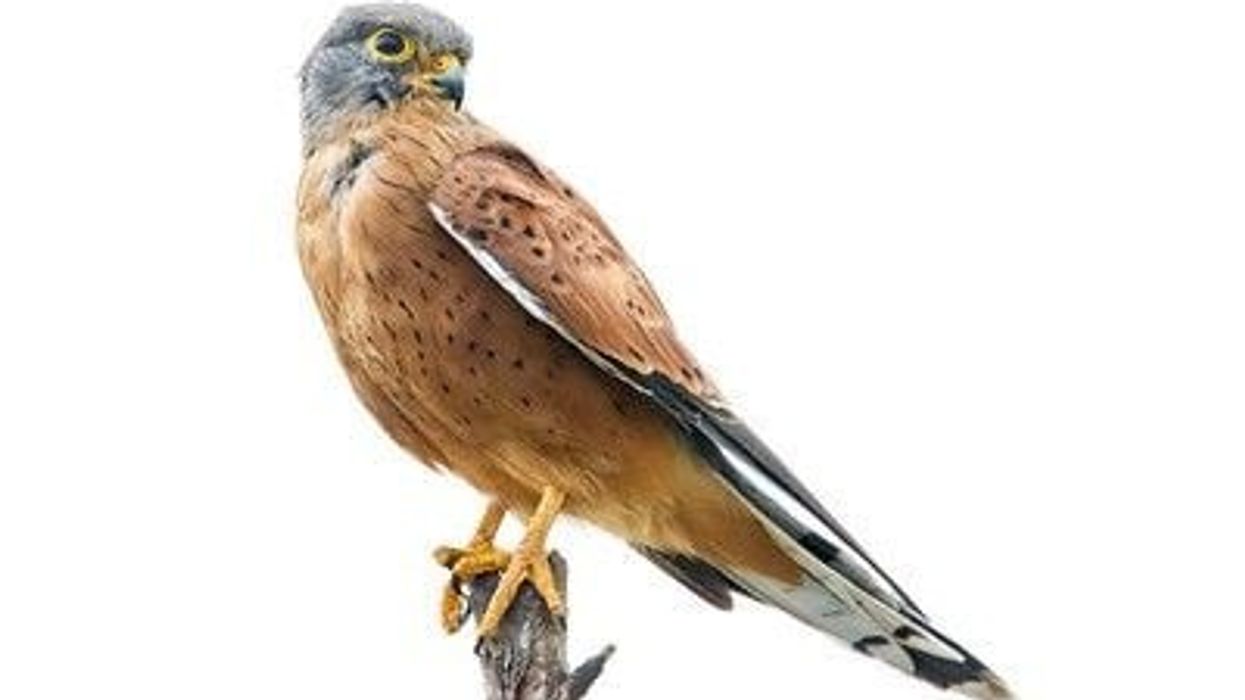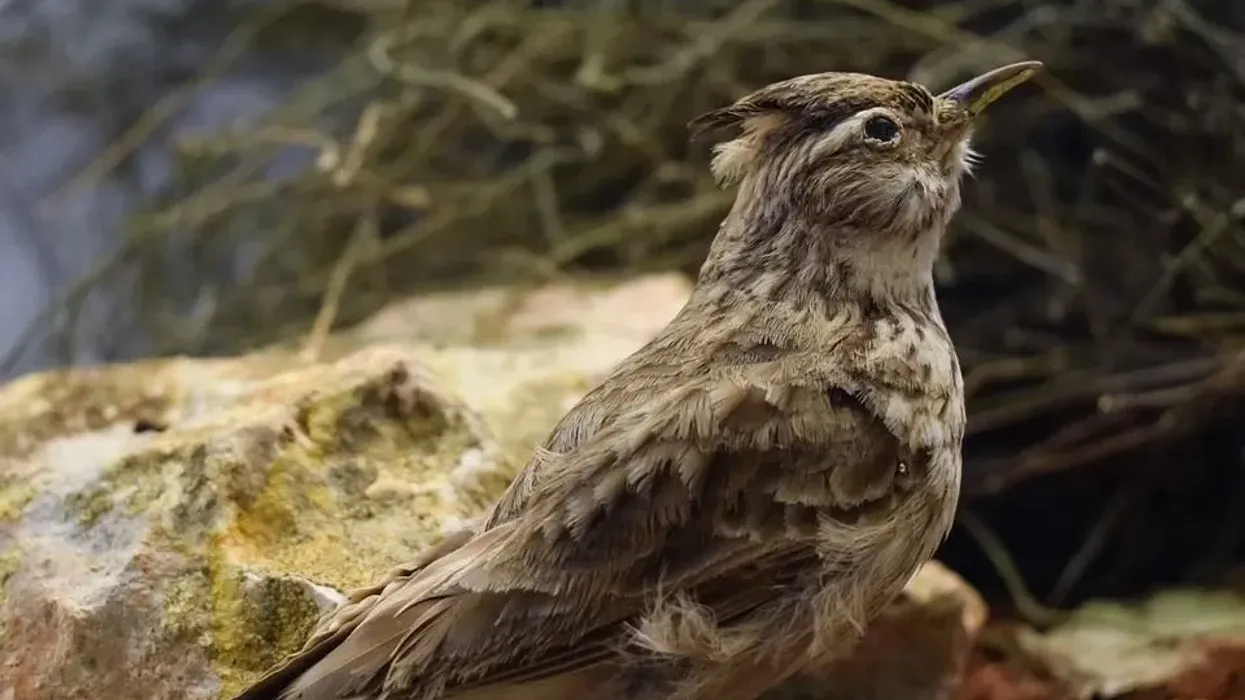A crested lark is small, bulky, and has a short tail. It can be easily found in less vegetation habitat areas as temperate habitat suits them. These birds are found in European countries like Germany, North Africa, India, Asia, West Asia, Portugal, and the South of Niger.
It is 6.7 in (17 cm) in length, almost similar to the size of the skylark. They are usually brown or gray in color. The identification is easily done with a crest on the head.
Birds of this species' population range from 22,000,000-91,200,000 mature individuals globally. During the breeding season, crested larks build their nest on the open ground using grass, twigs, and moss.
Females lay three to five eggs. After 10-15 days, chicks leave their nest. They remain loyal to the individual they pair with, and the union can last for more than a year.
They sing quite often and probably during a flight. The song sounds like 'twee-tee-too.' It is similar to the Thekla lark species' song.
If you enjoy reading about the crested lark, check out interesting facts about lark sparrow and horned lark.
Crested Lark Interesting Facts
What type of animal is a crested lark?
It is a small, brown bird from the Alaudidae family, found in mainland Europe and central Asia. There are 33 subspecies recognized so far.
What class of animal does a crested lark belong to?
The crested lark (Galerida cristata) is a type of bird belonging to the class Aves.
How many crested larks are there in the world?
The population ranges from 22,000,000-91,200,000 mature individuals globally.
Where does a crested lark live?
It is a native of Europe like in German provinces. They are found in Northern Africa and are common in some parts of Western Asia and China.
From Portugal to north-eastern China and eastern India, and south to Niger in Africa, they breed throughout temperate Eurasia. It has no migration habits, and it is only a rare vagrant here despite breeding as close to northern France country as possible.
It is also found in the south of Ethiopia and even in the south of Nepal. Its sedentary nature is evident by the fact it is only a scarce vagrant to Great Britain.
What is a crested lark's habitat?
They are commonly found in areas with scarcity of vegetation or drylands like farmland, agricultural lands, airfields. They are also found near roadsides, sand patches on rail tracks, and docks.
Who do crested larks live with?
Small groups of larks, including females, males, and offspring, are preferred by the species. The bird usually lives in pairs or, more commonly, a small flock of three to five birds. They have the ability to gather up to 15 people to find food when food is scarce.
How long does a crested lark live?
The lifespan of a crested lark (Galerida cristata) species is observed to be one to five years old.
How do they reproduce?
The male begins searching for a mate in the spring. The rituals include running around, singing, flapping the plumage, and extending the neck.
The female builds the nest, and it's on the ground, not in the tree's canopy. The construction of the structure can be made of any material: grass, twigs, cobwebs, and moss.
Females usually lay two sets of eggs a year, the first can be as many as six yellowish eggs, and the second can be up to four eggs. Two to ten weeks are required for hatching.
The incubation period is 10-15 days. Newly hatched chicks are fed three to five times a day by their parents, bringing in animals such as beetles, insects, and worms. The chicks begin to search for food independently after leaving the nest at about 9-10 days.
Those who do it poorly are still fed by the parents. After three weeks, the fledglings have grown up and left the nest to live independently.
Males defend their territories against predators and rivals. Male crested larks try to daze others who enter the territory with loud song sounds.
What is their conservation status?
This species has been considered under the IUCN red list of threatened species as a Least Concern.
Crested Lark Fun Facts
What do crested larks look like?
Their identification is easily done with the prominent crest on the head. It has a plumage length of 11.4-15 in (29-38 cm).
It is quite large compared to its body. During flight, its underwings appear reddish.
Unlike the Thekla Lark, its beak has more pronounced black-brown streaks and darker underwings on the European specimens; the difference between the two is a gray underwing that does not appear on the Asian specimens. As the lark often walks and a lot in search of food, its claws have to be very strong and twined with muscles.
How cute are they?
The appearance of these small birds is not very tidily organized, and they don't have a very colorful plumage. But they have a really mesmerizing voice.
How do they communicate?
A lark's voice serves as its main weapon. As soon as the danger is looming, the attacker is disoriented by the ear-piercing cry.
A male calls a female for mating with this tool. The young male begins to prove that he's more competitive than his peers. Potential male partners engage in a battle.
In this, the males surround the female, shaking their tails and stretching their necks as they spread their wings and spread their wings, all the while singing continuously, without pausing. In this case, the highest preference has been given to the longest-held out candidate.
How big is a crested lark?
Their height is 6.7 in (17 cm). It is almost similar in size to Eurasian skylark species but a bit smaller, bulkier body and rounded head. These birds are also similar to the Thekla lark species but a bit longer.
How fast can a crested lark fly?
This species can fly at the top speed of (37 kph) 23 mph.
How much does a crested lark weigh?
They weigh up to 0.08-0.12 lb (37-55 g).
What are the male and female names of the species?
There are no separate names for the two sexes of this species. They are also sometimes known by their scientific name Galerida cristata.
What would you call a baby crested lark?
The baby crested lark is called the chicks.
What do they eat?
Their diet includes plant origins and all kinds of insects. They are not picky and eat whatever is found. They eat ants, beetles, worms, mantis, and paper wasps. The diet also includes plant seeds, frozen berries, and cereals.
Are they friendly?
They are not very friendly. They are always on high alert because of their enemies like cats, mongooses, snakes, or some other bird species.
Would they make a good pet?
They are not usually kept as pets.
Did you know...
They sing continuously without stopping and can even sing during their flight. Their song can last for 15 minutes.
They love playing with the sand as they often have a dirty appearance.
Trees are difficult for the lark to climb simply because of its finger structure - a long claw grows on the backside of the foot, making it difficult to sit on a tree needle. Thus they dislike trees. They also don't make their nests on trees but open ground like agricultural land or farmland.
During territorial or courtship displays and when singing, the distinctive crest from which the species gets its name becomes more evident.
Types of crested lark
There are 33 subspecies of crested lark of the Alaudidae family recognized so far. Some of them are the Caucasian crested lark, Cyprus crested lark, Indian crested lark, Sudan crested lark, and Gilgit crested lark. They are found in German provinces and Indian countries.
What does a crested lark sound like?
They have a lovely voice with a combination of fluting, trilling, and whistling. It's like Thekla lark but a full composition of a song.
It sounds like 'whee-whee-wheeoo' or a 'twee-tee-too.' There are usually two to four syllables in a crested lark's song, one of which is extended and fairly flat. While the performance of the phrase is still vibrant in comparison to that in Thekla Lark, its pitch doesn't rise and fall in such an accented way.
Here at Kidadl, we have carefully created lots of interesting family-friendly animal facts for everyone to discover! Learn more about some other birds from our magpie-lark facts and western meadowlark facts pages.
You can even occupy yourself at home by coloring in one of our free printable crested lark coloring pages.









